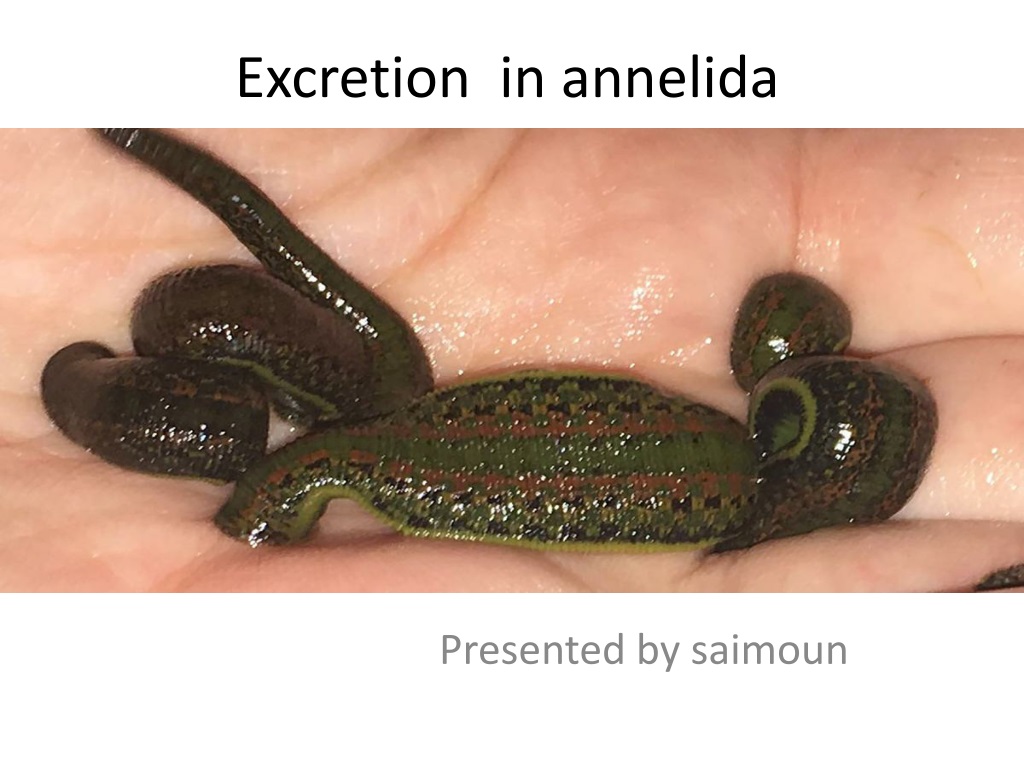

0 likes | 1 Views
Excretion in annelids is vital for maintaining homeostasis by eliminating excess substances and metabolic wastes. Annelids excrete substances like ammonia, urea, and water through organs like nephridia and coelomoducts. Nephridia are key excretory organs in annelida, with types like protonephridia and metanephridia, serving to remove waste and convey genital products. Coelomoducts, derived from gonads, can also function as excretory organs. Chloragogen cells aid in waste storage and transport in annelids, resembling the liver's function. Nephromixia combines metanephridia with coelomoducts. The physiology of excretion involves material uptake, reabsorption, secretion, and expulsion mechanisms.

E N D
Excretion in annelida Presented by saimoun
Excretion • Excretion is the removal of unwanted substances or metabolic wastes from body of an organism to the medium • Why is excretion essential ? • Excretion maintains the body”s homeostasis by the elimination of excess substances or metabolic by- product (toxic) that enter the body .
Excretory substances of annelids -Ammonia -Urea -Amino acids -water -Different ions ,etc.
Excretory organs of Annelida 1.Primary excretory organs - Nephridia 2.Secondary excretory organs – Coelomoducts ,Chloragogen cells.
Coelomoducts Mesodermal in origin ,developed from gonads, grow out and opens to the exterior by a genital pore. Primarily function as gonoducts , but in some forms they may secondarily acts as excretory organs .
Nephridia • Nephridium is the primary excretory organ in annelida. • A pair of nephridia on each segment . • Ectodermal in origin ;developed from external surfaces ;grow into the body ;opens to the exterior by a nephridiopore . • The nephridia are lined with short , hair-like projections called cilia that beat repeatedly to maintain the flow of fluid through the organ .
Functions of Nephridia • Primarily serve for excretion . • Secondarily serve to convey the genital product to the exterior .
Types of Nephridia •Based on closed or open tubule- •1.Protonephridia 2.Metanephridia •Protonephridia :-Primitive type ; terminates in the coelom as blind tube i.e. closed ;terminates with peculiar specialized excretory flame cells/ solenocytes . eg. Nephridia of phyllodoce , vanadis etc.
Metanephridia :- Advanced type ;inner pre-septal end opens into coelom by a ciliated funnel ,nephrostomes ;no solenocytes. E.g. Nephridia of Lumbricus ,leeches etc.
PROTONEPHRIDIA • Excretory organs of larvae and adult polychaetes. • The protonephridial system have a tubular arrangement that open to the exterior through a nephridiopore. • These have tubes with blind ends where cilia mediated filtration occurs. • Two types of protonephridia are recognized based on its terminations – 1.Flame cells or cyrtocytes 2.Solenocytes
FLAME CELLS • The protonephridia whose blind ends terminate in flames cell. • These cells are bulb-like in appearance hence called flame bulbs. • These bears a cluster of cilia within the cup- like projection ,whose beating is like a candle flame.
SOLENOCYTES • About 500 solenocytes in the nephridium. • Flagellated ;tiny rounded nucleated cell body and along hollow stalk or tubule. • Solenocyte can be distinguished from flames cells as the former is usually flagellated whereas the later is ciliated. • Associated with excretion ,osmoregulation and ionoregulation in many annelids. • Found in phyllodocids , alciopids and a few others.
METANEPHRIDIA • Far advanced nephridia. • The inner end of the tubule may open into the coelom through a ciliated funnel , called nephrostome. • Found in oligochaetes(Lumbricus),polychaetes (Neathenes ),Leeches etc.
• TYPES OF NEPHRIDIA –Based on size and number of nephridia – • 1.Micronephridia or Meronephridia • 2.Meganephridia or Holonephridia Micronephridia Meganephridia 1. Smaller in size , but numerous per segment. 2. Networks of fine tubes lying on the body wall and septa in each segment. 3. Example : Nephridia of Pheretima 1.Larger in size ,but generally one pair per segment. 2.Usually extend over two segments and their nephrostomes open into the segments next in front. Example :Nephridia in Hirudinea
• Types of nephridia :- Based on site of opening - 1. Exonephridia or ectonephridia • 2. Enteronephridia Exonephridia Enteronephridia 1.Opens to the excretory canals or alimentary canals. 2. Nephridiopores absent. 3.Septal and pharyngeal nephridia of pheretima. 1.Directly opens to the exterior. 2. Nephridiopores present . 3. Integumentary micronephridia of pheretima, meganephridia of nereis ,hirudinaria ,lumbricus etc.
CHLORAGOGEN Star shaped and are also called as Y cells. Derived from inner coelomic epithelium. Yellowish in colour due to yellow granules ,chloragosomes. Functions as liver in annelids. They store and transport nitrogenous wastes, basically urea.
NEPHROMIXIA • Association of metanephridia with coelomducts . • A combination of mesoderm and ectoderm . • Compound segmental organs. • Serve for both Excretion and exit of gametes .
TYPES OF NEPHROMIXIA • Based on degree of combination these are following types :- • 1.Protonephromixium coelomduct+protonephridium,e.g. phyllodoce 2.Metanephromixium coelomduct+metanephridium,e.g.Hesione 3.Mixonephromixium coelomduct+Nephridium;e.g.Arenicola 4.Ciliated organs coelomduct reduced to ciliated organs;e.g.Nereis
PHYSIOLOGY OF EXCRETION • 1.Uptake of material /filtration from the blood. • 2.Tubular reabsorption • 3. Tubular secretion . • 4.Expulsion from the body.